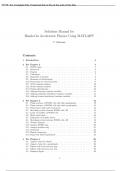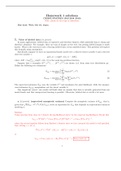Exam (elaborations)
Hands On Accelerator Physics Using MATLAB® 1st Edition By Volker Ziemann (Solution Manual)
- Course
- Institution
Hands On Accelerator Physics Using MATLAB®, 1e Volker Ziemann (Solution Manual) Hands On Accelerator Physics Using MATLAB®, 1e Volker Ziemann (Solution Manual)
[Show more]




